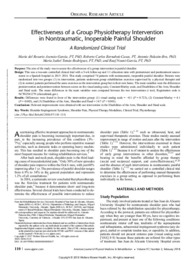Por favor, use este identificador para citar o enlazar este ítem:
https://hdl.handle.net/11000/34612Registro completo de metadatos
| Campo DC | Valor | Lengua/Idioma |
|---|---|---|
| dc.contributor.author | Asensio-García, María Del Rosario | - |
| dc.contributor.author | Bernabeu Casas, Roberto Carlos | - |
| dc.contributor.author | Palazón-Bru, Antonio | - |
| dc.contributor.author | Tomás-Rodríguez, Maria Isabel | - |
| dc.contributor.author | NOUNI GARCÍA, RAUF | - |
| dc.contributor.other | Departamentos de la UMH::Patología y Cirugía | es_ES |
| dc.date.accessioned | 2025-01-16T18:00:35Z | - |
| dc.date.available | 2025-01-16T18:00:35Z | - |
| dc.date.created | 2018-02 | - |
| dc.identifier.citation | American Journal of Physical Medicine & Rehabilitation. 2018 Feb;97(2):110-115 | es_ES |
| dc.identifier.issn | 1537-7385 | - |
| dc.identifier.issn | 0894-9115 | - |
| dc.identifier.uri | https://hdl.handle.net/11000/34612 | - |
| dc.description.abstract | Purpose: The aim of the study was to assess the effectiveness of a group intervention in painful shoulder. Design: This was a two-arm controlled clinical trial with a 5-wk follow-up and 1:1 allocation ratio with pretreatment and posttreatment assessments in a Spanish hospital in 2015-2016. This study comprised 74 patients with nontraumatic, inoperable painful shoulder. Patients were randomized into two groups: (1) in intervention, patients underwent group rehabilitation exercises supervised by a physical therapist and (2) in control, patients performed the same exercises as the intervention group but in their own home. The main variables were the differences preintervention and postintervention between scores on the visual analog scale, Constant-Murley scale, and Disabilities of the Arm, Shoulder and Hand scale. The mean differences in the main variables were compared between the two interventions (t test). Registration code is NCT02541279 (clinicaltrials.gov). Results: Differences were found in favor of the intervention group: (1) visual analog scale = -0.1 (P = 0.723), (2) Constant-Murley = 4.1 (P = 0.085), and (3) Disabilities of the Arm, Shoulder and Hand = 14.7 (P < 0.001). Conclusions: Relevant improvements were obtained with our intervention in the Disabilities of the Arm, Shoulder and Hand scale | es_ES |
| dc.format | application/pdf | es_ES |
| dc.format.extent | 6 | es_ES |
| dc.language.iso | eng | es_ES |
| dc.publisher | Lippincott, Williams & Wilkins | es_ES |
| dc.rights | info:eu-repo/semantics/openAccess | es_ES |
| dc.rights | Attribution-NonCommercial-NoDerivatives 4.0 Internacional | * |
| dc.rights.uri | http://creativecommons.org/licenses/by-nc-nd/4.0/ | * |
| dc.subject | Shoulder Impingement Syndrome | es_ES |
| dc.subject | Shoulder Pain | es_ES |
| dc.subject | Physical Therapy Modalities | es_ES |
| dc.subject | Clinical Trial | es_ES |
| dc.subject | Physiotherapy | es_ES |
| dc.title | Effectiveness of a Group Physiotherapy Intervention in Nontraumatic, Inoperable Painful Shoulder: A Randomized Clinical Trial | es_ES |
| dc.type | info:eu-repo/semantics/article | es_ES |
| dc.relation.publisherversion | 10.1097/PHM.0000000000000817 | es_ES |

Ver/Abrir:
Effectiveness of a Group Physiotherapy Intervention in Nontraumatic, Inoperable Painful Shoulder. A Randomized Clinical Trial.pdf
228,5 kB
Adobe PDF
Compartir:
 La licencia se describe como: Atribución-NonComercial-NoDerivada 4.0 Internacional.
La licencia se describe como: Atribución-NonComercial-NoDerivada 4.0 Internacional.
.png)